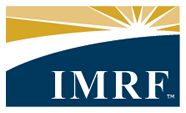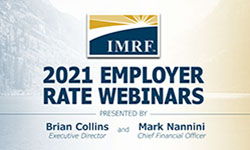View the 2021 program presented by IMRF Executive Director Brian Collins and Chief Financial Officer Mark Nannini.
2021 Rate Webinar Resources
IMRF conducted three 2021 Employer Rate webinars on May 4 at 10 AM, May 12 at 2 PM and May 20 at 11 AM. Brian Collins, Executive Director, and Mark Nannini, Chief Financial Officer, provided an in-depth review of the impact of year-end financial and actuarial data on IMRF, and the data's estimated impact on individual IMRF employers. During the presentation, attendees were invited to submit real-time questions. This recap of the Employer Rate webinar includes a link to view the webinar program in its entirety, a link to download the presentation's slides, attendee comments, and a transcript of the questions posed during the program, with detailed answers.
Attendee Comments
- "The webinar was very helpful."
- "Thank you for creating such great content for employers!!"
- "I truly enjoyed this training"
- "Excellent Presentation"
Question and Answer Presentation
Q1.: What was the fund’s 2020 net return?
A1.: IMRF earned a 2020 net investment return of 14.79%, after portfolio management fees, doubling its assumed rate of return of 7.25% for the year.
Q2.: Has there been discussion regarding reducing the investment assumption rate from the current 7.25%?
A2.: The Board of Trustees reviews all IMRF actuarial assumptions, including the investment return assumption, each December. The Board discussed the possibility of lowering the investment return assumption at its most recent December meeting, but ultimately no changes were made.
Q3.: Since the benefits for Tier 2 cost less than Tier 1, will Tier 2 reduce employer costs significantly in the future?
A3.: It costs about 40% less to provide a Tier 2 pension versus a Tier 1 pension. The reduced costs are already depressing employer contribution rates and will continue to do so.
Q4.: Why isn’t there a pdf version of the benefit handbook on the website? There is a Spanish version but not an English version.
A4.: Due to the web-centric initiative, we have discontinued the paper English-language benefit booklet. Direct your employees to the website to learn about their benefits. All the information from the benefit booklets, and more, exists on the website. The Spanish-language benefit booklet still exists because, unlike the English-language version, there is information in it that is not on our website.
The same is true of all the other booklets that remain on our website, such as the disability and past service booklets. After IMRF better integrates the content from these booklets into the website and adjusts the associated mailings, these booklets will also be removed.
The web-centric initiative has already saved IMRF $405,000 and 2,668,524 sheets of paper in 2020.
Q5.: Why would a decrease in our staffing result in an increase in employer rate? If we have a smaller payroll, it should follow that we have less IMRF liability.
A5.: If the size of the workforce decreases, the reportable payroll is smaller. So, there is less money coming in to pay future benefits, which ultimately will increase your future employer rate.
Q6.: How do unpaid sick days at retirement affect the employer rate?
A6.:A member will earn one month of service credit for every 20 days of unused, unpaid sick time he/she has at retirement, up to a maximum of one year credit. So, yes, it does affect the employer rate, but only minimally.
While the payout for unused sick and/or vacation time is not a salary increase, the payment does increase the member’s pension – which also increases the cost to the employer. This increased cost was not funded over the working career of the member, creating an unfunded liability, or shortage, in the Employer Reserve. If these wages were exempt from Accelerated Payments, the employer would be required to pay higher contributions in the future to pay for both the shortage in their reserve plus interest. The interest is necessary to provide for the missed investment opportunity because the funds were not available to invest by IMRF.
Q7.: I understand that an employee's retirement amount is based on their four highest earning years of their last 10 years of work. Isn't that a disincentive to promote someone to a much higher paying job in the last 10 years of their career?
A7.: Salary does affect pension amounts. When setting employer contribution rates, IMRF follows the assumptions approved by the Board of Trustees. Over the long-term, if employers provide salary increases in excess of the assumption, it will place upward pressure on contribution rates. Certain salary increases during a member’s Final Rate of Earnings (FRE) period can result in an Accelerated Payment invoice from IMRF. Salary increases resulting from promotion are exempt from Accelerated Payments. Learn more about Accelerated Payments here.
Q8.: Are the excess returns compared to the MSCI index that you displayed due to the larger U.S. equity returns compared to that index over the last decade?
A8.: Partially, as well as the overall IMRF portfolio performance.
Q9.: Are Voluntary Additional Contributions taken as pre-tax contributions?
A9.: No, they are after tax, not tax deferred. Read more about VAC on our web site by selecting your plan type, and then selecting Voluntary Additional Contributions from the menu.
Q10.: What assumptions does IMRF make about male and female life expectancy? In other words, how long do they expect them to live on average?
A10.: IMRF relies on certain demographic and economic assumptions to estimate the fund’s liabilities, and ultimately, to determine employer contribution rates.
See page D-6 of the Annual Actuarial Valuation Report 12/31/2020 (available on Employer Access in June) for assumptions on age of retirement and life expectancy



